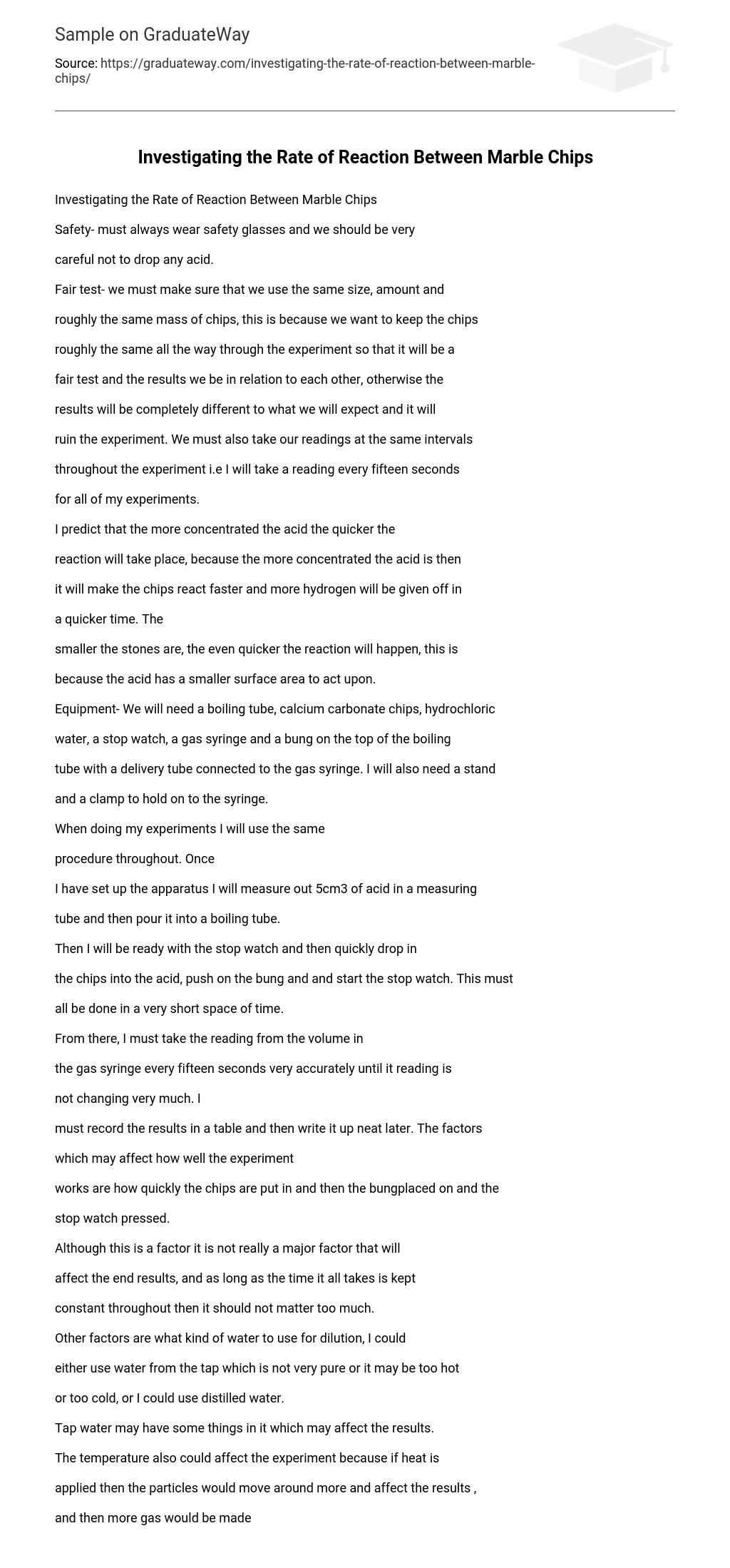To ensure safety, it is important to always wear safety glasses and prevent any acid from being dropped. Moreover, for a fair experiment, it is crucial to use chips that are of equal size, quantity, and have similar mass. This will guarantee uniformity in the experiment and produce comparable outcomes. Neglecting these precautions may result in unforeseen discrepancies in the results and compromise the validity of the experiment.
We must ensure that our readings are consistently taken at regular intervals throughout the experiment. To be precise, I will record a measurement every fifteen seconds for all of my experiments. My hypothesis is that using a more concentrated acid will accelerate the reaction. This higher concentration of acid should cause the chips to react faster and ultimately release a larger quantity of hydrogen within a shorter timeframe.
The reaction will happen even quicker if the stones are smaller because the acid has less surface area to act upon. For this experiment, we will need a boiling tube, calcium carbonate chips, hydrochloric water, a stop watch, a gas syringe, and a bung on the top of the boiling tube with a delivery tube connected to the gas syringe. Additionally, we will need a stand and a clamp to hold the syringe. I will consistently follow the same procedure for all my experiments.
Once the apparatus is set up, 5cm3 of acid will be measured out in a measuring tube and then poured into a boiling tube. At this point, the stop watch should be ready and the chips should be quickly dropped into the acid. The bung should be pushed on and the stop watch should be started in a very short amount of time. From there, the volume in the gas syringe should be accurately recorded every fifteen seconds until the reading stabilizes. The results should then be recorded in a table for later neat writing.
The success of the experiment can be affected by different factors such as the speed of chip insertion, bung placement, and stopwatch pressing. However, these factors do not have a significant impact on the final results. If the time taken remains constant, their effect should be minimal. Another factor to consider is the type of water used for dilution. Tap water, which may lack purity and have varying temperatures, or distilled water can both be utilized. The presence of certain substances in tap water could potentially influence the outcome of the experiment.
The temperature may impact the experiment as applying heat would cause increased particle movement, potentially influencing the results and resulting in more gas production. It is recommended to obtain one result for each concentration initially and repeat any experiments if necessary. To obtain optimal results, proper utilization of the equipment is crucial. One way to ensure this is by twisting the gas syringe back and forth to prevent it from getting stuck, which could affect the accuracy of our findings.
To obtain the best marbles, it is important to sift the chips. It is crucial to use the correct amount of acid and the optimal size and quantity of marbles. If I use about 4 chips for 4mol, too much gas will be produced and the syringe will quickly exceed the 100 mm3 capacity. This would prevent accurate readings. To address this issue, we will test the ideal number and size of chips to use. My previous trialexperiments were helpful in determining the appropriate amount and size of chips.
After conducting initial experiments, I determined that using one medium-sized chip weighing approximately 0.63g would yield the best results. However, it is important to note that if one chip is utilized, it must be consistent in size and used for all concentrations. Additionally, we conducted a previous experiment to provide us with guidance and insight. The experiment involved the reaction between Magnesium and hydrochloric acid, which proved beneficial in familiarizing us with the equipment and setting expectations for future endeavors.
I have utilized various resources for my project, including my notebook and the GCSE Chemistry Gallagher and Ingram textbook. These sources provided me with substantial information. Upon evaluating the evidence, I am confident that the experiment was successful. All the desired results were obtained and they appear to be accurate. This allows me to draw a sound conclusion. Upon examining the results, I observed no unfavorable outcomes, demonstrating that everything proceeded smoothly. Despite the favorable outcome of the experiments, I chose to repeat one concentration of acid twice to verify if consistent results could be achieved – and indeed, they were. The apparatus functioned without any notable errors or malfunctions.
For the only possibility to occur, which is a change in the acid temperature between the first reading and the finish, the temperature of the acid would have needed to change. In other words, it is hoped that from when we did the first experiment, the acid would have remained at the same temperature. Based on my results and graph analysis, I can conclude that a higher concentration of acid resulted in a faster reaction and increased gas production. The graph clearly shows that in all five results, the reaction occurred more rapidly at the beginning compared to later stages where it started slowing down.
Before conducting the experiments, I formed predictions about the reaction between hydrochloric acid and calcium carbonate. My assumption was that a higher concentration of acid would result in a faster reaction and increased production of hydrogen. These predictions were proven accurate, enabling us to now explore our primary hypothesis regarding the influence of acid concentration on the rate of reaction.





